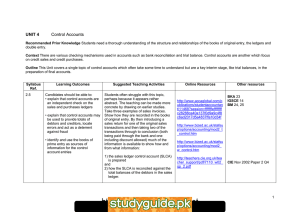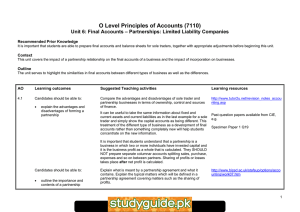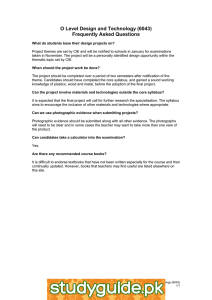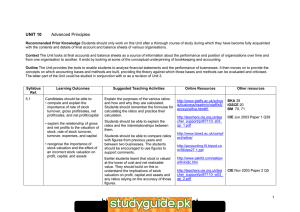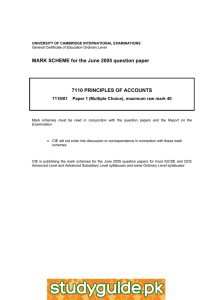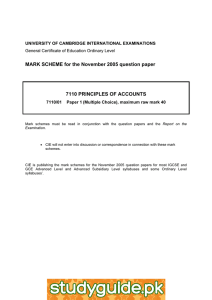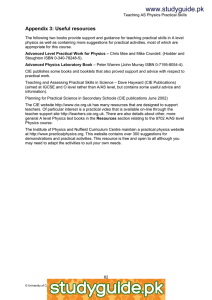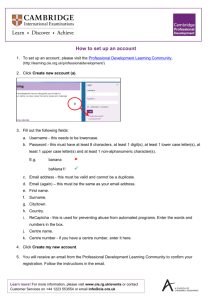UNIT 6 Final Accounts – Partnerships: Purchase of a Business
advertisement
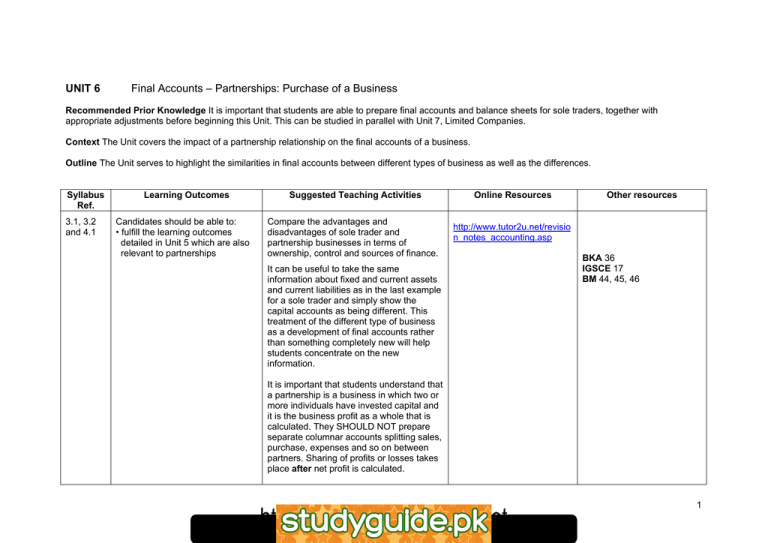
UNIT 6 Final Accounts – Partnerships: Purchase of a Business Recommended Prior Knowledge It is important that students are able to prepare final accounts and balance sheets for sole traders, together with appropriate adjustments before beginning this Unit. This can be studied in parallel with Unit 7, Limited Companies. Context The Unit covers the impact of a partnership relationship on the final accounts of a business. Outline The Unit serves to highlight the similarities in final accounts between different types of business as well as the differences. Syllabus Ref. 3.1, 3.2 and 4.1 Learning Outcomes Candidates should be able to: • fulfill the learning outcomes detailed in Unit 5 which are also relevant to partnerships Suggested Teaching Activities Compare the advantages and disadvantages of sole trader and partnership businesses in terms of ownership, control and sources of finance. Online Resources Other resources http://www.tutor2u.net/revisio n_notes_accounting.asp It can be useful to take the same information about fixed and current assets and current liabilities as in the last example for a sole trader and simply show the capital accounts as being different. This treatment of the different type of business as a development of final accounts rather than something completely new will help students concentrate on the new information. BKA 36 IGSCE 17 BM 44, 45, 46 It is important that students understand that a partnership is a business in which two or more individuals have invested capital and it is the business profit as a whole that is calculated. They SHOULD NOT prepare separate columnar accounts splitting sales, purchase, expenses and so on between partners. Sharing of profits or losses takes place after net profit is calculated. http://www.xtremepapers.net 1 Syllabus Ref. 3.3 Learning Outcomes Suggested Teaching Activities Candidates should be able to: • know the importance and contents of a partnership agreement Explain what is meant by a partnership agreement and what it contains. Explain the typical matters which will be defined in a partnership agreement covering matters such as the sharing of profits. • make simple entries for the formation of a partnership via capital contribution by each partner in cash and/or non-cash assets and amalgamation of two sole traders, including the calculation and recording of Goodwill Illustrate how sharing profit may not be equal because the capital injection may not be equal, or the commitment of one partner to a business may be less in terms of management than another and this is reflected in profit share. Explain and work through examples of goodwill and how it is included in accounts. Journal entries and ledgers should be fully covered to prevent students reversing the entries. This is a common error in examination answers. Online Resources Other resources http://www.bized.ac.uk/stafsu p/options/accounting/work07. htm http://teachers.cie.org.uk/tea cher_support/pdf/7110_w03_ qp_1.pdf CIE Nov 2003 Paper 1 Q21, 26 http://www.bized.ac.uk/stafsu p/options/accounting/work08. htm Questions will not be set on the dissolution of partnership. 2 Syllabus Ref. 4.2 Learning Outcomes Suggested Teaching Activities Candidates should be able to: • prepare partnership Trading and Profit and Loss Accounts, Appropriation Accounts and Balance Sheets A key difference between partnerships and sole traders is the use of appropriation accounts. This is the part of the final accounts in which profits or losses are shared between partners. • show the treatment of interest on capital, partners' salaries, interest on partners' loans and on drawings It is helpful for students to increase the number of transactions in the appropriation account steadily. Initially, begin with the sharing of profits. Then add partners’ salaries, then interest on capital and drawings, gradually increasing the complexity. Online Resources Other resources http://accounting10.tripod.co m/content.htm http://www.askltd.com/askjav a/partners.htm http://teachers.cie.org.uk/tea cher_support/pdf/7110_s03_ qp_1.pdf CIE Jun 2003 Paper 1 Q31 http://www.accaglobal.com/p ublications/studentaccountan t/13217?session=fffffffeffffffff c28288ca40a137f0d9a9c4f8 c6ad2017d5a4837ffa10d34f Ensure students thoroughly understand the place of drawings and that they do not appear in the appropriation account. • draw up partners' current and capital accounts both in ledger form and as part of a Balance Sheet presentation Explain the reasons for and against using current accounts in a partnership and the implications of both on the bookkeeping. Illustrate and provide practice for students in preparing current and capital accounts. http://teachers.cie.org.uk/tea cher_support/pdf/7110_w02_ qp_2.pdf CIE Nov 2002 Paper 2 Q3 Complete the study of partnerships by working through a full set of partnership final accounts and balance sheet. Students can be confused about when to use columnar current/capital accounts. A consistent approach of using separate full ledger accounts outside the balance sheet, bringing the closing balance to the balance sheet is less confusing for students. 3 Syllabus Ref. 2.6 Learning Outcomes Candidates should be able to: • record the assets and liabilities acquired in the books of the purchasing business (sole trader or partnership) • calculate and record Goodwill Suggested Teaching Activities One of the ways in which a business can expand is to purchase another. This involves taking over the assets and liabilities including any goodwill. Online Resources Other resources BM 47 The bookkeeping is similar to the formation of a business through contribution of cash and assets from partners. Students should, in this case, be shown the calculation of goodwill as the surplus of purchase price over net assets. They should be able to account for goodwill and the net assets. 4
